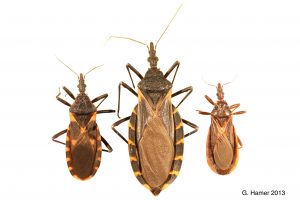The parasitic infection, Chagas disease, was first discovered in 1909 by Brazilian physician Carlos Chagas. According to the World Health Organization, an estimated more than 10,000 people die every year from clinical manifestations of Chagas disease, and more than 25 million people risk acquiring the disease.
It is caused by the parasite Trypanosoma cruzi, and the disease is also referred to as American trypanosomiasis.
Hutchinson Distinguished Professor of Biological Sciences at Loyola University New Orleans, Patricia Dorn, PhD joined me to discuss Chagas disease and her class trip to Guatemala.
Podcast: Play in new window | Download
Subscribe: Apple Podcasts | RSS

Image/Rachel Curtis–Hamer Labs
Related:
- Chagas disease: UTEP scientists granted patent for first ever vaccine
- Dr. Peter Hotez on World Chagas Day 2017
- Chagas study: Confirms it is a major public health challenge for the US
- Chagas outbreak in northern Brazil possibly linked to food served at party
- Chagas disease vector spread linked to cardboard boxes: Study
- Chagas disease burden in the Rio Grande Valley of Texas
- Bedbugs can acquire and transmit the Chagas parasite: Penn researcher
- Virginia the epicenter of Chagas in the US: Report
- Chagas drug, fexinidazole, goes into Phase II trials
- Chagas disease: Benznidazole IND receives FDA clearance



One thought on “A look at the neglected tropical disease, Chagas disease”